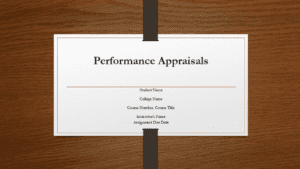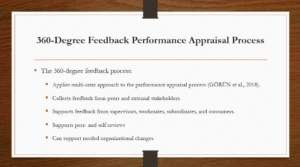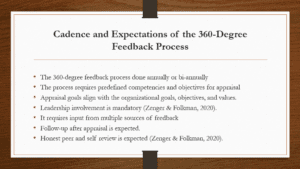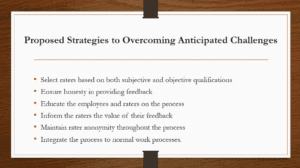Performance Appraisal Proposal
Hello. This presentation will cover the 360-degree Feedback performance appraisal process in response to the HR director’s request to reassess the current performance appraisal process and expectations applied across the organization. We will present a summary of the 36-degree Degree process, the cadence and expectations of the process, and the benefits of this performance appraisal process. Additionally, it will cover any anticipated challenges by using the 360-degree Feedback performance appraisal process and proposals on overcoming them.
360-degree feedback is an approach to performance appraisal that focuses on rating data from multiple sources of feedback (GÖRÜN et al., 2018). The rating feedback comes from peers, workmates, supervisors, managers, consumers, and customers. The process, besides peer reviews, also supports self-review of performance. Therefore, the 360-degree Feedback performance appraisal focuses on the broader employee environment as the data source for rating performance. As a multi-source feedback process, the 360 feedback process can support the implementation of needed changes after the appraisal process has been concluded.
The 360-degree feedback process can be performed once or twice a year. The annual or bi-annual assessments allow for enough time for the employee to work on the previous feedback from the previous appraisal and, at the same time, provide a timely evaluation of the employee since previous feedback was provided. The 360-degree process requires predefined competencies and objectives for appraisal. The competencies and goals appraised are expected to align with the organization’s goals, objectives, and values. Additionally, the organization’s leaders are expected to be a part of the process to define the direction of appraisal and identify the sources of rating data (Zenger & Folkman, 2020). The 360-degree feedback process in performance appraisal further requires honest input from multiple sources of feedback, as well as honest peer and self-review, is expected. Most importantly, the process expects follow-ups from the employee after the appraisal has been concluded.
Applying 360-degree feedback to appraise the performance of the employees has a lot of major benefits that make it suitable it to replace the current performance appraisal method. For instance, the 360-degree feedback performance appraisal process allows feedback from multiple resources, thus eliminating rating errors and bias. This can further improve the rating accuracy and outcomes of the appraisal process. The process also improves the employees’ self-awareness as they get to be rated on various items from the perspectives of their peers and other people they link within the work settings (Zenger & Folkman, 2020). The process through multi-source rating can help identify areas and opportunities for development as well as design future performance objectives (Yudithama et al., 2019). This overall process has been linked with improved employee productivity (Olusadum & Leo, 2021). Additionally, the 360-degree performance appraisal process improves organizational communication, teamwork, and collaboration, with an impact on individual employee performance (Yudithama et al., 2019). Additionally, based on the multi-source feedback received, the data received can be used to support decision-making at the organizational level.
A number of challenges are anticipated with the implementation of the 360-degree feedback performance appraisal process. Some major challenges include a poorly defined selection process for the raters. The selection may be influenced by subjective aspects, which may further affect the quality of feedback from some raters. Additionally, setting up and implementing the process is expected to consume a lot of productive time due to the high number of raters as well as the amount of data collected and analyzed. It is also expected that some of the raters will be unable to provide feedback on some aspects of the appraised employee. Additionally, a major anticipated challenge is that some of the employees and raters may not be aware of the process or how it is implemented.
The anticipated challenges led us to develop the following solutions to improve the efficiency and effectiveness of the 360-degree feedback performance appraisal process. First, the raters will be selected based on subjective and objective qualifications to provide quality feedback as well as ensure that the raters are as honest as possible with their feedback. Additionally, the process implementation will be planned earlier to provide time to educate the raters and the employees to be appraised to familiarize themselves with the process and how to integrate the process into the normal work day to minimize disruptions.
To conclude our presentation, it is important to note that the 360-degree feedback performance appraisal process can improve the appraisal process as it uses multiple perspectives to provide rating data due to its inclusive approach to rater selection. It also creates opportunities for self-reflection and improvement based on the feedback provided. Regardless of the challenges of implementing the process, early planning, training, and guiding the employees and raters throughout the process can help to easily overcome the challenges.
References
GÖRÜN, M., KAYAR, İ., & VAROL, B. (2018). 360-Degree Performance Appraisal and Feedback System: A Study with Heads of Departments in Çanakkale Onsekiz Mart University. Gaziantep University Journal of Social Sciences, 17(4). https://doi.org/10.21547/jss.449154
Olusadum, N. J., & Leo, M. I. (2021). 360-DEGREE FEEDBACK APPRAISAL SYSTEM AND EMPLOYEE PRODUCTIVITY OF DEPOSIT MONEY BANKS IN IMO STATE, NIGERIA. In Global Journal of Human Resource Management (Vol. 9, Issue 2).
Yudithama, D., Nugraha, F. N., & Pratami, D. (2019). Performance Appraisal Design Using 360 Degree Feedback at University X. 195–200. https://doi.org/10.2991/ICOIESE-18.2019.35
Zenger, J., & Folkman, J. (2020, December 23). What Makes a 360-Degree Review Successful? Harvard Business Review. https://hbr.org/2020/12/what-makes-a-360-degree-review-successful
ORDER A PLAGIARISM-FREE PAPER HERE
We’ll write everything from scratch
Question
HR issues are a concern for every industry, but especially health care. It is important to acknowledge current issues in order to examine future healthcare issues. This week, you’ll explore the changing role of HR management in response to those issues.

Performance Appraisal Proposal
course.content.assessment.
Homework
Performance Appraisal Proposal
Homework Content
Scenario
The HR director approached the HR team requesting a reassessment of the current performance appraisal process and expectations. The HR director has broken the department into small groups and asked each group to research and propose a performance appraisal process to be reviewed by the HR director and company board.
Assignment Deliverable
choose 1 performance appraisal process (or create a new process based on a combination of several) to propose.
Create a 6- to 8-slide presentation proposing your group’s selected performance appraisal process. Include the following in the presentation:
A summary of the performance appraisal process
The cadence and expectations of the process
The benefits of this performance appraisal process
Any anticipated challenges with the performance appraisal process and how they will be overcome









